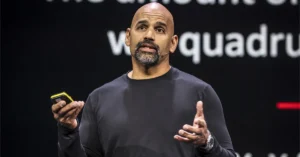TL;DR:
- JD Vance claims AI will boost productivity and create jobs rather than cause mass unemployment.
- Recent data shows entry-level roles in tech, finance, and other white-collar sectors are declining rapidly due to automation.
- Industries with abundant data, like software development and customer service, are seeing the fastest AI adoption.
- Workers must upskill and adapt to hybrid human-AI roles to stay competitive.
- Experts warn that without proactive reskilling, AI could widen inequality in the workforce.
U.S. Vice President JD Vance has pushed back against fears that artificial intelligence will trigger mass unemployment, saying AI will create opportunities and “make us more productive, more prosperous, and more free.” Speaking at the AI Action Summit in Paris, February, Vance argued, “If the robots were coming to take all of our jobs, you would see it already.”
Vance’s comments reflect the Trump administration’s pro-worker AI strategy, which frames the technology as a complement to human labor rather than a replacement. “Too many leaders in the AI industry, when they talk about this fear of replacing workers, miss the point,” he told attendees.
Evidence of Uneven AI Impact
While Vance’s remarks stress optimism, recent data show that AI’s impact varies widely across sectors. In data-rich industries such as software development, customer service, and finance, automation is accelerating rapidly. GitHub reports that three-quarters of developers now use AI coding assistants, while IBM says AI-powered customer support can cut costs by 23.5%. In U.S. equity markets, high-frequency algorithmic trading — driven by machine learning — already accounts for around 70% of volume.
In data-poor industries such as construction, healthcare, and education, adoption is slower due to privacy laws, fragmented data systems, and inconsistent record-keeping. For example, HIPAA limits the availability of surgical datasets, and FERPA restricts the use of student performance data, curbing AI’s ability to train in those sectors.
Entry-Level Jobs Under Pressure
In the 2025 job market, AI is fundamentally reshaping the entry points for new professionals. According to Final Round AI, companies are increasingly using generative AI for tasks that traditionally served as training grounds for junior employees, resulting in a 20% drop in entry-level postings across tech and finance this year alone.
A Reuters report highlights the closure of coding bootcamps that once served as gateways to tech careers, with AI platforms like GitHub Copilot now automating basic programming work previously handled by novices. The New York Times notes that unemployment among recent college graduates has surged to 12.4%, the highest in over a decade.
Major firms such as Microsoft and Google have acknowledged AI-driven efficiencies as a factor in layoffs, disproportionately affecting entry-level roles. Social media posts from industry observers point to a 15% year-over-year decline in corporate entry roles and a 400% increase in job descriptions mentioning AI skills.
Broader White-Collar Risks
The shift is not limited to technology. CTech reports declines in junior analyst and paralegal roles, now handled by AI systems that can process large datasets and produce reports at scale. In an interview with The Times of India, Bill Gates warned that AI could eliminate up to 50% of entry-level white-collar jobs within five years.
Economic research from JPMorgan, suggests the next recession could hit white-collar knowledge workers harder than past downturns. For the first time, workers from non-routine cognitive occupations — including scientists, engineers, and lawyers — account for a greater share of unemployment than non-routine manual workers.
Adapting to the New Reality
Despite these challenges, experts note that AI is also creating new career paths. Built In highlights emerging opportunities in AI ethics, prompt engineering, and systems maintenance. The World Economic Forum (WEF) predicts that by 2030, AI could create as many jobs as it displaces — but only if reskilling and education keep pace.
CNBC reports that companies are beginning to integrate AI training into internships, creating hybrid roles that combine human judgment with machine capabilities. Meanwhile, NPR warns that without policy intervention, AI may accelerate inequality, automating low-level roles while increasing wealth concentration among top earners.
JD Vance’s message of AI optimism stands in contrast to growing evidence of disruption at the lower rungs of the white-collar job ladder. The technology is indeed creating opportunities — but the benefits and burdens are unevenly distributed.
Whether AI’s long-term impact matches Vance’s vision or economists’ warnings will depend on how quickly workers, companies, and policymakers adapt to a future where the first rung on the career ladder is no longer guaranteed.
The Bottom Line
JD Vance’s message of AI optimism stands in contrast to growing evidence of disruption at the lower rungs of the white-collar job ladder. The technology is indeed creating opportunities — but the benefits and burdens are unevenly distributed.
Whether AI’s long-term impact matches Vance’s vision or economists’ warnings will depend on how quickly workers, companies, and policymakers adapt to a future where the first rung on the career ladder is no longer guaranteed.
ⓘ As part of our ongoing support for startups and SMEs, LAFFAZ Media publishes feature and resource articles that may include references and links to external websites. These inclusions are selected at our editorial discretion to provide valuable information to our readers. LAFFAZ Media does not control, endorse, or assume responsibility for the content or practices of external websites. For more details, please refer to our Terms and Conditions.






